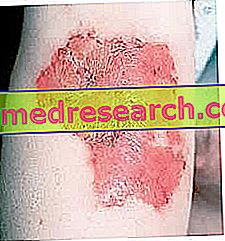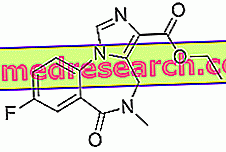Key points
The excoriation is a superficial wound of the skin, in which there is an export of more or less extensive epidermal layers, a consequence of peeling, rubbing or collisions against rough surfaces.
Excoriations: causes
Excoriations are caused by rubbing or scratching against rough walls or objects. Even the dragging of blunt instruments can create excoriations. Athletes and children are the categories most at risk of falls, therefore also of bruises.
Excoriations: symptoms
Excoriations can cause pain, the intensity of which depends on the extent of the injury. Other symptoms associated with excoriation include: edema, perception of limited heat and bleeding.
Excoriations: treatment
Slight bruises do not require special care. The more extensive ones require the accurate cleaning of the wound: after removing any foreign body that is undermined in the excoriation, proceed with the disinfection of the area. If necessary, apply pain-relieving substances and bandage the skin.
Definition of excoriation
Excoriation is defined as any superficial skin wound: we are talking about the removal of more or less extensive epidermal layers, a sort of peeling, caused by bumps, rubbing or scraping against rough surfaces.

Every living being is a possible target of bruises; nevertheless, it is understandable that children and athletes are more exposed to risk.
According to some authors, the terms "excoriazione" and "abrasione" are synonymous. Others believe, instead, that there is a noticeable difference between the two lesions: abrasions are considered slightly more serious than abrasions.
But how do they get bruises? What are the symptoms? How can they be treated?
During the discussion, we will try to shed light on these questions.
Causes
The most frequent excoriations in absolute terms are the expression of rubbing or scratching of the skin against walls, surfaces or rough objects: the friction generated by the contact between the skin and the surface can damage the external tissue of the epidermis, therefore creating excoriation, more or less bleeding.
Sports lovers are more prone to bruises, because they are constantly exposed to the risk of falls or sports accidents.
Excoriations are also an expression of the entrainment of blunt instruments on the skin, which flow tangentially with respect to the skin surface.
Signs and symptoms
Excoriations give rise to lesions of modest clinical entity: we recall, in fact, that the excoriations properly called involve only the superficial layer of the epidermis.
It is not uncommon for excoriations to be associated with variable hematomas, such as ecchymoses, purpura or petechiae.
Similar injuries cause pain, whose intensity depends on the trauma suffered; pain is often associated with edema (swelling) and perception of heat / tension directly on the injured point.
Classification
Depending on the severity of the injury inflicted, it is possible to classify the abrasions by degrees:
- First degree excoriation : the lesion only involves the extreme epidermal layer. In this case, the excoriation is light, to the point that it does not affect the dermis: therefore there is no bleeding, but simply a serum-lymphatic exudate. These slight excoriations are characterized by the formation of a yellowish eschar (crust), which comes off a few days after the injury.
- Second degree excoriation : the lesion goes just beyond the epidermis, also involving the dermis. In this case, the excoriation is often bleeding and is characterized by the formation of a brown serum-blood eschar, which dries after 5-7 days. By detaching itself, the crust leaves a fabric with a slightly different color scheme than those of healthy skin.
- Third degree excoriations: the damage is such as to involve the subcutaneous tissue (hypodermis). In this case, it is incorrect to speak of excoriation properly so called: the lesion is dressed in the most important pathological meaning, and assumes the connotation of avulsion .
Shape and dimensions
It is not possible to describe the shape and standard dimensions of a graze, since each lesion is unique. In general, the bruises have an irregular shape, although on some occasions they perfectly reproduce the characteristics of the blunt instrument (figured excoriations).
Excoriations: treatments
Small wounds and minor bruises are of simple resolution; can be treated at home, so it is not necessary to go to the emergency room. Deep wounds, on the other hand, require medical supervision and medication. In general, bruises are of little clinical value, since the return ad integrum is rather fast (speed of resolution).
What to do
But how should one behave in case of abrasion?
First of all, it is necessary to proceed by carefully washing and cleaning the damaged area. After that, it is recommended to disinfect the excoriation with specific antiseptic substances, paying particular attention to the removal of any splinters or foreign bodies that are found in the wound. We recommend using a sterile gauze to remove foreign bodies in the wound.
Before touching the excoriation, it is recommended to wash your hands thoroughly with soap and water to prevent a trivial lesion from acting as a front door for pathogens.
In the event of bleeding excoriation, apply hydrogen peroxide directly to the wound; after removing any foreign bodies, wrap the excoriation with sterile bandages. The bandage should be replaced one or more times during the day, depending on the severity of the injury.
If the lesion is very slight, bandaging is not necessary: exposure of the lesion to the air promotes healing.
For infection prevention, it is recommended to apply an antibiotic (eg bacitracin) directly in the excoriation.
Particular attention must be paid to the excoriation of patients not subjected to tetanus vaccination. Tetanus is a non-contagious, potentially fatal infectious disease contracted following the entry of Clostridium tetani into the skin: wounds and abrasions from infected shards or nails can trigger the infection.
In case of moderate pain it is recommended to apply topical analgesics (eg lidocaine or benzocaine); to appease intense pain, oral anti-inflammatory / analgesic drugs are recommended.
The application of ointments, gels, sprays or gauzes impregnated with hyaluronic acid (eg Connettivina) can accelerate the repair and regeneration of the skin, accelerating the healing of excoriations.
It is recommended not to expose the abrasion to sunlight, to avoid the formation of permanent hyperpigmentation.



